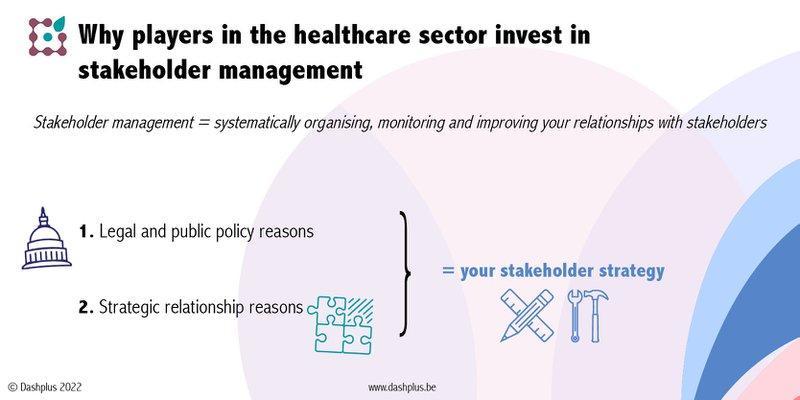This is the 2nd article in our stakeholder management series. Check out the full report to read them all.
As a company in the healthcare industry, you are probably extremely focused on your product or service and how it impacts your users. And rightly so! Congratulations are in order: you are indeed working with your main stakeholder in mind.
But: the healthcare ecosystem is extremely complex and rigid. So if you’re working on some change, broader stakeholder engagement will be crucial.
What is stakeholder management?
It’s all about ‘systematically organising, monitoring and improving your relationships with stakeholders’. The latter refering to ‘any person or organisation having an interest in the implementation, financing or outcome of a product or process by another party'. Stakeholder management needs an action plan and specific skills in your team.
In general, players in the healthcare sector have two reasons to invest in stakeholder management:
1) Legal and public policy reasons:
- sometimes, stakeholder consultation is legally required or is part of an approval process e.g. in the field of GDPR or technical approval
- when adjustments to the public reimbursement framework are needed. This takes time and you will need to be familiar with the decision-making processes
- to ensure an ‘equal level playing field’: equal and transparent access rules for all players in a specific HC system
- to help policy makers in reaching specific policy goals, for example: a growth of 100k people back to work after illness, or: health equity
- for larger organisations stakeholder management is a corporate governance requirement. Listed companies, for example, need an action plan to engage with their most important internal (employees, ..) and external (partners, public policy, society) stakeholders.
Usually this task belongs to the public affairs department or general management. It’s more formal and process-based.
2) Strategic relationship reasons:
- responding to a growing focus on and culture of information exchange
- to develop a relationship with stakeholders that is not only necessary, but evolves and leads to mutual understanding and respect, ensures better results on the ground. For example: this is how Bayer invests in stakeholder dialogue.
- co-creation: stakeholder feedback leads to new ideas for products and services, with greater added value
- for convincing corporate governance and social commitment (not just because it is imperative)
- a better reputation
- a reduction in costs because of competitive advantage and better acceptance
This task often is part of the communication and PR-department.
Download the full report on stakeholder management in health care

Over the past decade, stakeholder management has evolved more and more to stakeholder engagement. This refers more to cooperation with stakeholders and is based on a Corporate Social Responsibility (CSR) approach.
You do not engage with every stakeholder to the same extent: your relationship will vary from ‘no interaction’ to ‘close ambassadorship’. So you will use different methods and channels depending on the engagement and partnership you want to achieve.
An all-encompassing stakeholder strategy therefore includes both the legal/public policy management side and the strategic relationships side. That’s why stakeholder management needs close cooperation within your team.
Your stakeholder management strategy: 5 questions to start with
When your company is defining a (new) stakeholder management strategy, start by answering these 5 questions:
- Why? In your current project, is it mainly the legal and policy side that is important, or do the strategic reasons take the upper hand?
- Team? Determine within your organisation who will take on the stakeholder management assignment: will it be a combined team from the public affairs and communications department? Is one person accountable or the whole team? Who will lead the actions?
- Decision-making process: is the team familiar with the specific regulations and decision-making processes involved? Is there expertise on who’s the decision-maker, on what aspect and with what deadline?
- Language: is your team familiar with the language and jargon your stakeholders use?
- Crucial objectives: What do you want to achieve-by when? Is your goal active (meaning that something happens) or rather passive (that something does not happen)?
Now you’re ready to move on.
You will plan your actions based on:
- A thorough stakeholder analysis: identification, segmentation, typology, stakeholder mapping
- Stakeholder goals and your attitude
- Policy and HC system cycle information
- New or existing relationship cycles with indicated stakeholders (engagement)
Your full stakeholder management plan will include diverse actions, channels and messages.
And although it’s important to make that kind of plan to structure your actions and outcome, it’s crucial to calculate flexibility: swift reactions, insights and relationships are crucial in successful stakeholder management.

What can you do next?
- Download our full report on stakeholder management in healthcare
- Read our newsletter if you want to stay tuned on new insights and articles on stakeholder management in healthcare
- Prepare your stakeholder plan with us: drop us an e-mail to schedule a digital meeting together. The first one is always free.
- Participate in a stakeholder webinar: we make sure the Belgian health system has no more secrets for you. Reserve your seat now >










